31.07.2025
SpaceX moves Starship to launch pad for testing ahead of Flight 10
Starship's 10th test flight is expected to take place sometime in August.
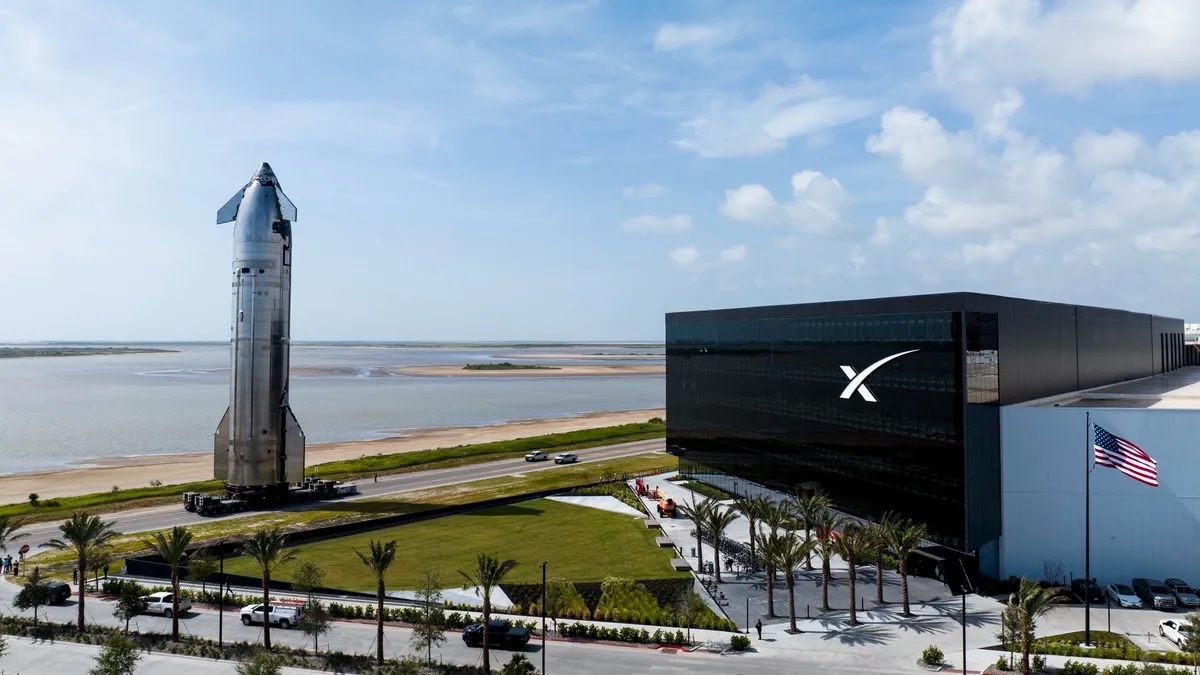
SpaceX moves its Flight 10 Starship upper stage to the pad at Starbase for testing. SpaceX posted this photo on X on July 28, 2025. (Image credit: SpaceX via X)
SpaceX has moved its Starship spacecraft to the launch pad for testing ahead of the vehicle's 10th flight, which is expected to take place next month from the company's Starbase site in South Texas.
SpaceX announced the milestone on Monday evening (July 28) in a post on X, which chronicled the journey of the 171-foot-tall (52-meter-tall) Starship upper stage in four photos.
SpaceX has not announced a target date for Flight 10, but it could happen soon: On July 14, company founder and CEO Elon Musk said the liftoff will occur in "about three weeks." On Monday, he provided an updated, yet more vague, prediction: "next month."
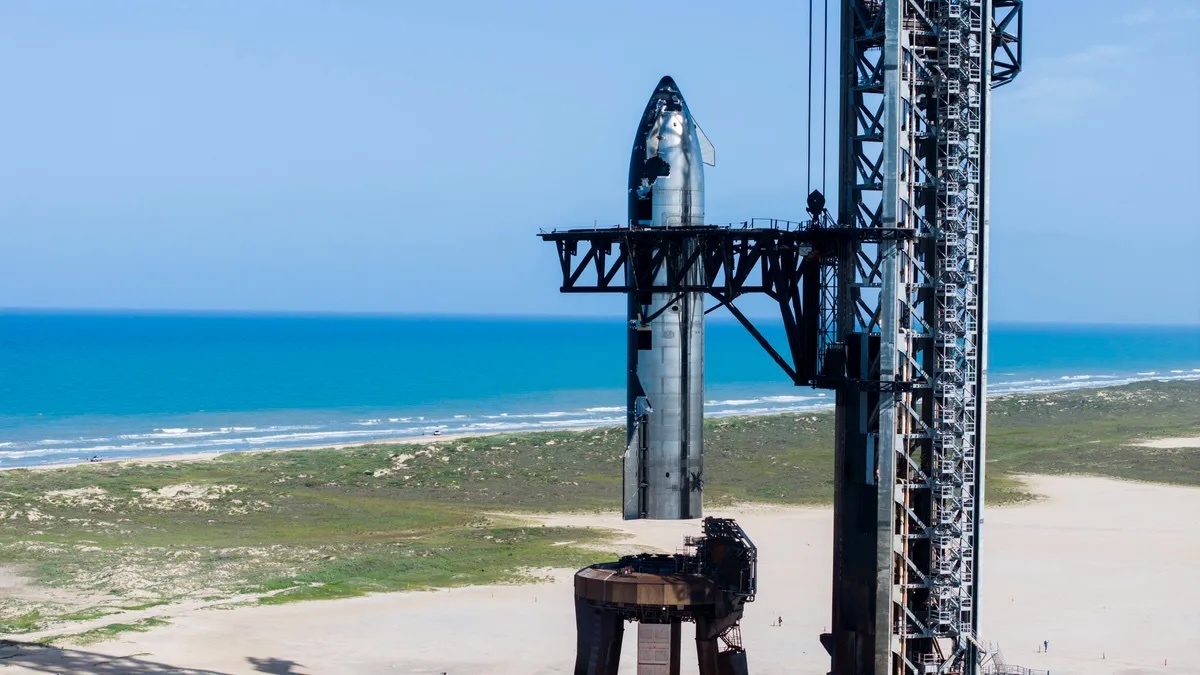
The Starbase launch tower uses its "chopstick" arms to place the Flight 10 Ship vehicle on the mount for testing. (Image credit: SpaceX via X)
SpaceX is developing Starship — the biggest and most powerful rocket ever built — to help humanity colonize Mars and perform a number of other ambitious exploration feats.
The 400-foot-tall (122-meter-tall) vehicle consists of two elements, both of which are made of stainless steel and designed to be fully reusable: a giant booster called Super Heavy and an upper-stage spacecraft known as Starship, or "Ship" for short.
The Ship that just moved to the pad is the second SpaceX has prepped for Flight 10. The first one exploded on a test stand at Starbase on June 18 while gearing up for a static fire, a common prelaunch trial in which a rocket's engines are briefly ignited while the vehicle remains anchored to the ground.
The company quickly determined the likely cause of that "rapid unscheduled disassembly" — the failure of a pressurized nitrogen tank near Ship's nose.
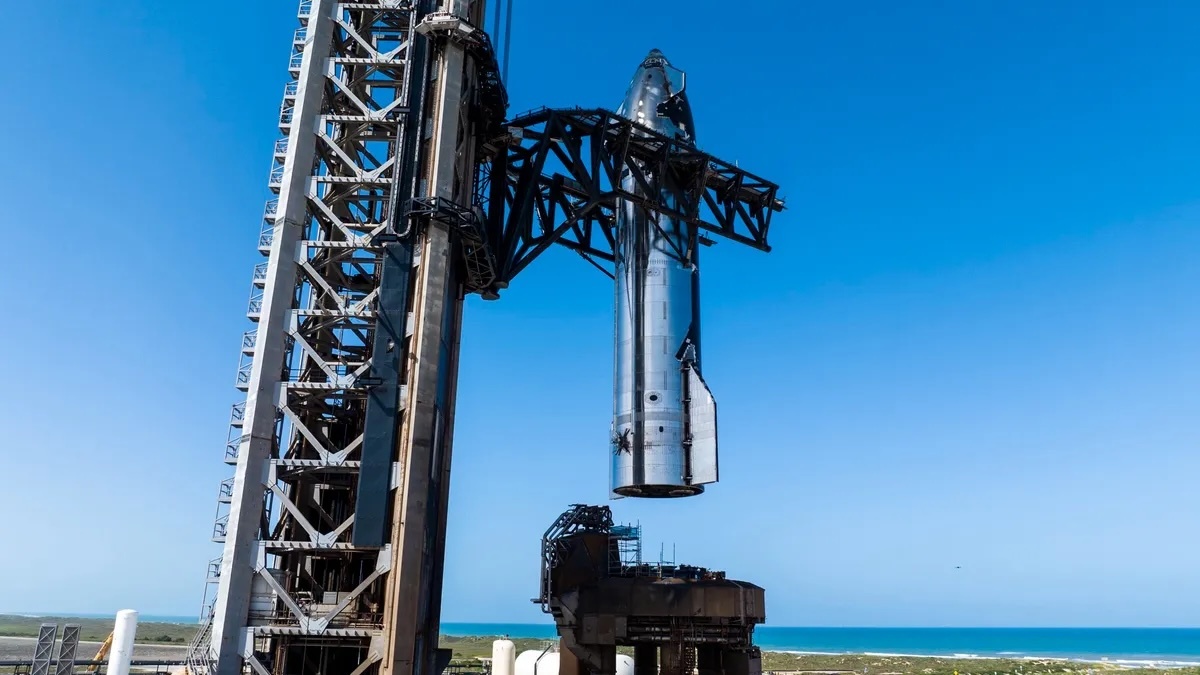
Starship Flight 10 will take place sometime in August, Elon Musk has said. (Image credit: SpaceX via X)
All eyes will be on Ship during Flight 10, for the upper stage has had some problems: SpaceX lost the vehicle on the three most recent Starship flights, which took place this past January, March and May, respectively.
Super Heavy, on the other hand, aced both Flight 7 and Flight 8, boosting Ship successfully and then coming back to Starbase for a catch by the launch tower's "chopstick" arms.
SpaceX didn't try such a catch on Flight 9, but rather tried to bring the booster back for a splashdown in the Gulf of Mexico. That didn't quite happen; Super Heavy broke apart just after starting its landing burn.
Quelle: SC
----
Update: 3.08.2025
.
SpaceX fires up Starship spacecraft ahead of 10th test flight
"Starship single-engine static fire demonstrating an in-space burn complete on Pad 1 at Starbase."
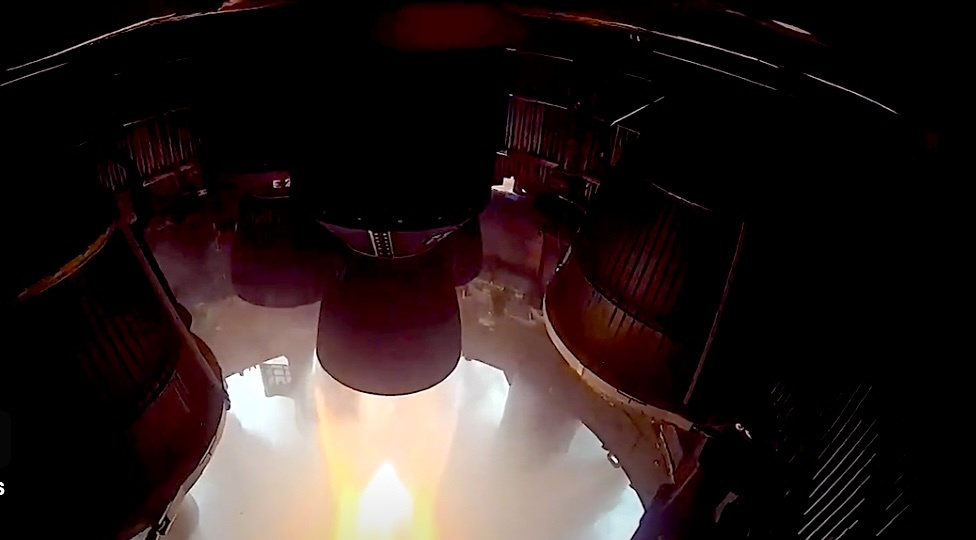
SpaceX just fired up its newest Starship spacecraft on Thursday (July 31), to help prep the vehicle for an upcoming test flight.
The company conducted a "static fire" trial with the 171-foot-tall (52 meters) Starship upper stage at its Starbase site in South Texas on Thursday, briefly igniting one of the vehicle's six Raptor engines.
"Starship single-engine static fire demonstrating an in-space burn complete on Pad 1 at Starbase," SpaceX wrote in a Thursday evening X post that shared two photos and a video of the milestone.
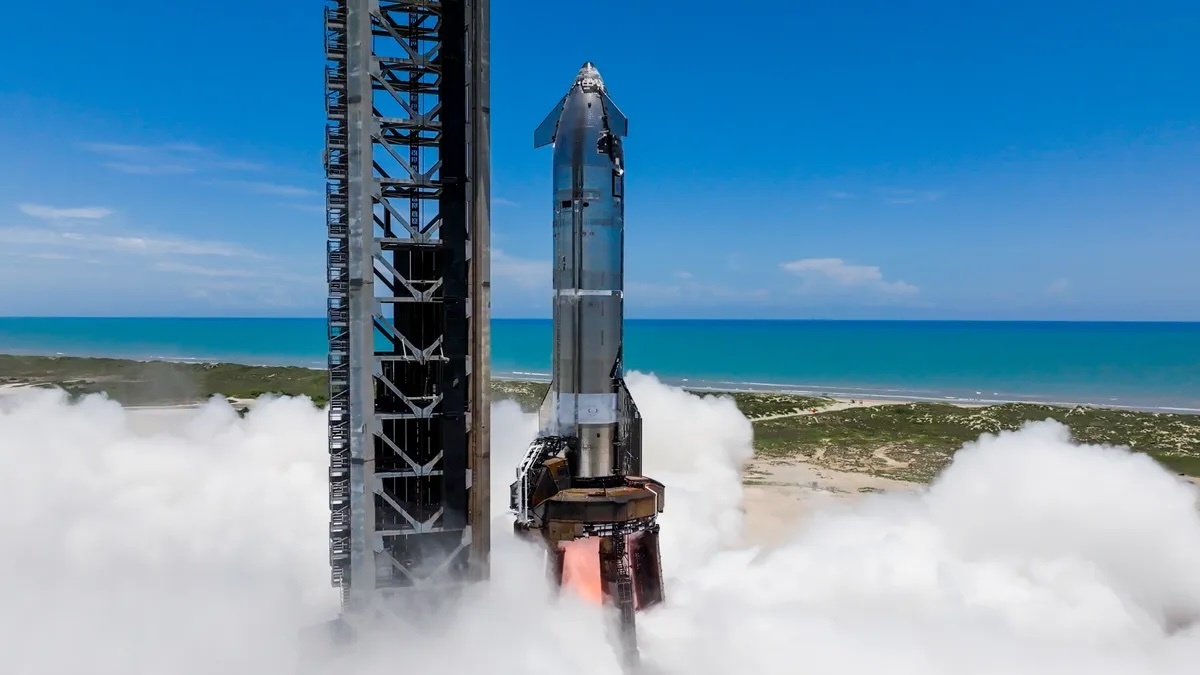
SpaceX conducts a static fire test with a Starship upper stage at its Starbase site in South Texas on July 31, 2025. (Image credit: SpaceX via X)
The test is part of the prep work for Flight 10 of Starship, the huge, fully reusable rocket that SpaceX is developing to help humanity colonize Mars and do a wide variety of other spaceflight work.
Starship consists of two elements — the upper-stage spacecraft, called Starship or simply Ship, and a huge booster known as Super Heavy. Both are made of stainless steel and are powered by Raptors (33 of them in Super Heavy's case).
This particular Ship is the second that SpaceX has earmarked for Flight 10. The first exploded on a test stand at Starbase on June 18 just before a planned static-fire test.
The Super Heavy that will fly on Flight 10 has already passed its static-fire test, igniting all 33 of its engines on June 6.
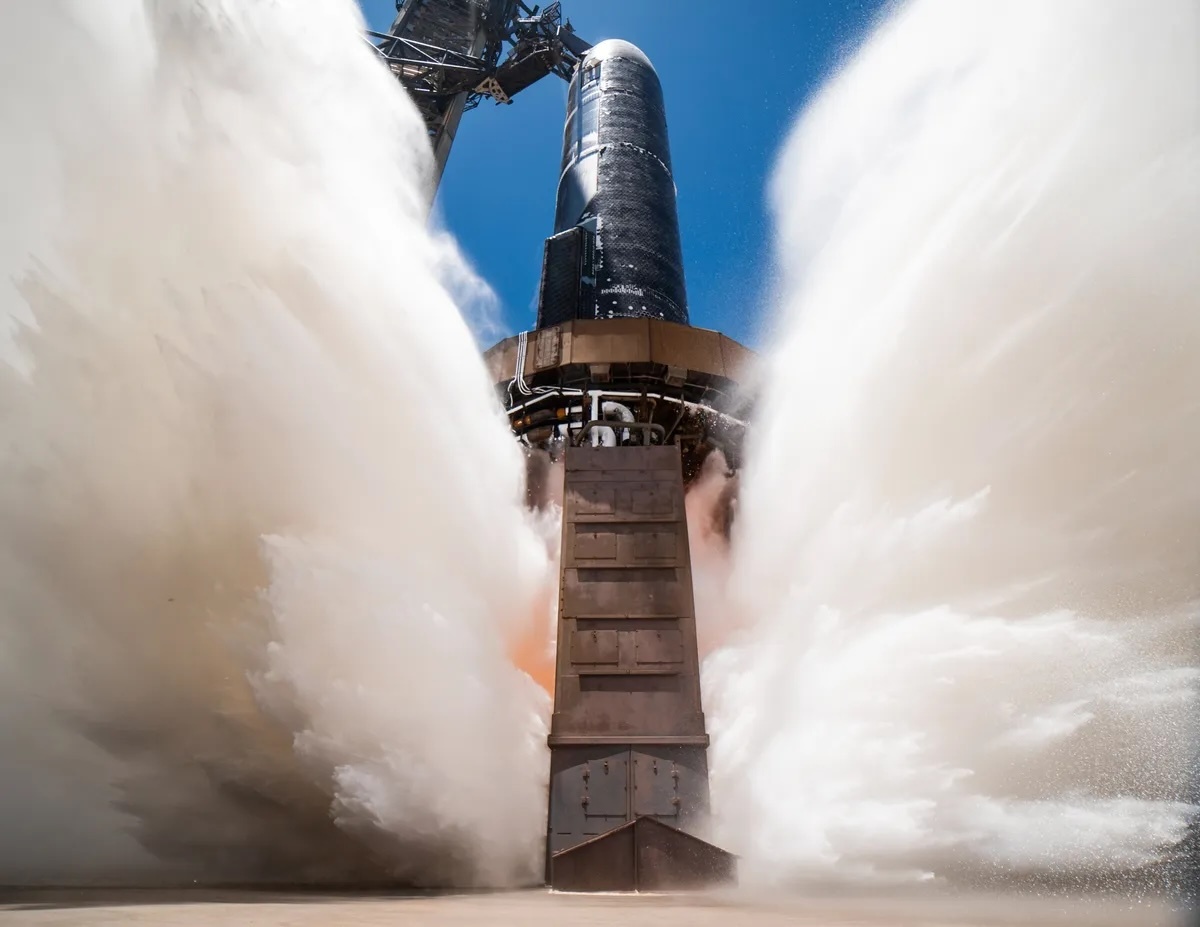
A closeup view of the July 31 Starship static fire, showing Starbase's water deluge system in action. (Image credit: SpaceX via X)
SpaceX has not yet announced a target date for Flight 10, but we may not have to wait long for it: company founder and CEO Elon Musk has said the test mission will launch in August.
A fully stacked Starship first flew in April 2023. The huge rocket has launched three times so far this year, in January, March and May. On all three flights, SpaceX lost the upper stage before its planned Indian Ocean splashdown.
Quelle: SC
----
Update: 16.08.2025
.
SpaceX schedules 10th test flight for Starship, details recent setbacks
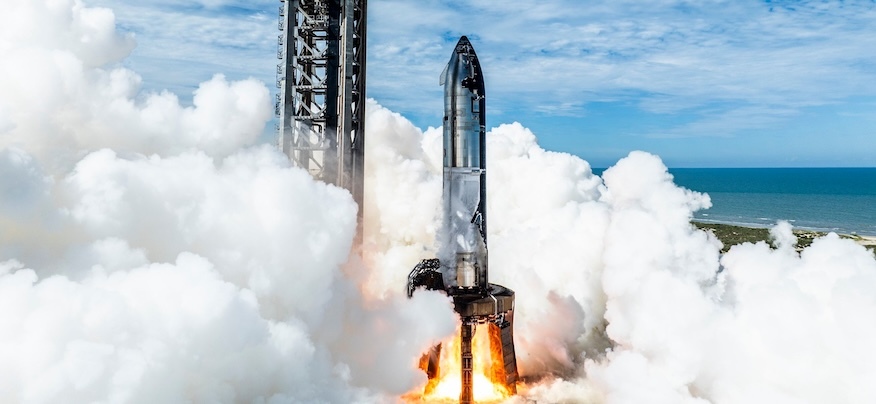
SpaceX’s Ship 37 performs a static fire test with all six of its Raptor engines as part of prelaunch testing ahead of the Flight 10 mission for the Starship program. Image: SpaceX
SpaceX is once again gearing up for a launch of its massive Starship rocket from southern Texas. On Friday, it announced plans for the tenth flight of the fully integrated, two-stage rocket as soon as Sunday, Aug. 24, from its headquarters in Starbase.
The test flight of the towering rocket is tentatively scheduled during an hour-long window that opens at 6:30 p.m. CDT (7:30 p.m. EDT / 2330 UTC). It comes three months after the previous test flight experienced multiple issues and two months after a test stand explosion destroyed the ship originally intended to fly this mission.
This tenth test flight of the fully-integrated Starship vehicle will use the Ship 37 upper stage and Booster 16.
“The upcoming flight will continue to expand the operating envelope on the Super Heavy booster, with multiple landing burn tests planned,” SpaceX wrote of the upcoming venture. “It will also target similar objectives as previous missions, including Starship’s first payload deployment and multiple reentry experiments geared towards returning the upper stage to the launch site for catch.”
That payload consists of eight large flat objects that SpaceX calls Starlink simulators, which are meant to replicate the size of the forthcoming third generation of satellites for the company’s broadband low Earth orbit constellation. SpaceX also wants to perform a relight of one of the six Raptor engines during the coast phase of the mission.
Both of those milestones were left unaccomplished in the prior three missions due to issues with the rocket’s upper stage. A post-flight assessment of Flight 9, which launched on May 27, found that Ship 35 was lost due to “a failure on the main fuel tank pressurization system diffuser.
“Cameras inside the vehicle showed a visible failure on the fuel diffuser canister, which is located inside the nosecone volume on the forward dome of the main fuel tank,” SpaceX wrote. “While pre-flight analysis did not show a predicted failure, SpaceX engineers were able to recreate the failure using flight conditions when testing at our facility in McGregor, Texas.”
In a 2016 publication, researchers at NASA’s Marshall Space Flight Center (MSFC) described a diffuser in a liquid-fueled rocket as a mechanism designed to “control the flow of the gas into the tank in order to prevent direct impingement of the gas on the liquid surface and/or the tank walls.”
“If the diffuser did not perform those tasks, the warm gas can create excess heat transfer causing an increase in the amount of pressurization mass required,” the paper stated.
SpaceX’s fuel tanks on both the Ship upper stage and Super Heavy booster are pressurized during flight by a method known as autogenous pressurization. At a basic level, this means that as the liquid methane (the fuel) is warmed up, its routed through the diffuser for pressurization.
While connected to the ground infrastructure during the fueling process, Starship uses gaseous nitrogen for pressurization. That ends shortly before liftoff.
During Flight 9, about three minutes into the six-engine burn of Ship 35 after stage separation, SpaceX said the sensors in the vehicle’s nosecone “detected a steady increase in methane levels.”
“This continued until approximately five minutes into the burn when pressure began to rapidly decrease in the main fuel tank while pressure simultaneously increased in the nosecone,” SpaceX said. “Starship’s systems were able to compensate for the drop in main tank pressure and completed the ascent burn, achieving the planned velocity and Second Stage Engine Cutoff (SECO).”
SpaceX said after SECO that unusual nosecone pressure combined with a planned venting from the nosecone caused the vehicle to lose attitude control, which eventually caused the venting to halt and prevented the planned deployment of Starlink simulators. The latter event was caused by the higher pressure in the nosecone creating “adverse loads on the mechanism responsible for opening the payload door.”
SpaceX used the reaction control thrusters on Ship 35 to help off-set the attitude problem and allow the nosecone venting to continue. About 40 seconds later though, liquid methane was seen inside the nosecone and a number of sensors showed the temperature was dropping in an unplanned manner.
“This eventually triggered automatic passivation commands on the vehicle, resulting in Starship skipping the in-space burn and venting all remaining propellant into space,” SpaceX said. “Starship reentered Earth’s atmosphere in an off-nominal attitude and communication was lost during entry.
“Final telemetry from Starship was received approximately 46 minutes into the flight test, while the vehicle was approximately 59 kilometers in altitude and inside the designated entry area over the Indian Ocean. There were no autonomous flight safety system mission rule violations or initiation of the flight termination system.”
Flight 9 wasn’t the only problem for the Ship upper stage. During ground testing at SpaceX’s Massey test facility near Starbase, Ship 36 exploded without warning during fuel loading ahead of a six-engine static fire test on June 18.
A post-anomaly analysis pointed to “undetectable or under screened damage to a composite overwrapped pressure vessel (COPV) in Starship’s payload bay section, which failed and resulted in structural failure of the vehicle causing subsequent propellant mixing and ignition. The COPVs in the payload section store gaseous nitrogen for use in the Starship environmental control system.”
“To address the issue, COPVs on upcoming flights will operate at a reduced pressure with additional inspections and proof tests added prior to loading reactive propellants onto a vehicle,” the company wrote. “SpaceX has also updated its COPV acceptance criteria and developed a new non-destructive evaluation method to detect internal COPV damage.
“New external covers are also being added to COPVs during their integration, adding an additional layer of protection and visual indication of potential damage.”
As a result of that explosion in June, SpaceX created a new rig for the Orbital Launch Mount at Pad A to allow fueling and static fire testing to be conducted at the launch site while repairs continue at Massey’s. On Aug. 1 and 3, SpaceX completed both a single-engine and a six-engine static fire test respectively with Ship 37, which will be used on Flight 10. It also conducted a spin prime test on Aug. 13 after returning the Ship to the pad after apparently replacing a Raptor engine.
If Ship 37 is able to make it through its planned milestones and to a controlled, atmospheric reentry it would be the first of the Block 2 version of Starship to do so. The first three attempts on Flight 7, Flight 8 and Flight 9 were all unsuccessful for the Block 2 model.
Because of that, SpaceX has yet to properly test a number of experimental heat shield tiles, including one with active cooling. SpaceX has also been unable test the ruggedness of the catch fittings on the side of the Ship upper stage that would be used for a catch attempt on a future mission.
There is also “a section of the tile line receiving a smoothed and tapered edge to address hot spots observed during reentry on Starship’s sixth flight test.”
“Starship’s reentry profile is designed to intentionally stress the structural limits of the upper stage’s rear flaps while at the point of maximum entry dynamic pressure,” SpaceX said.
Overcoming booster troubles
The performance of the Super Heavy booster used on Flight 9 was a mixed bag. On the positive side, SpaceX succeeded in performing a controlled flip maneuver of Booster 14 (B14), which hadn’t been tried before on previous missions. Prior to that, the booster’s trajectory after hot staging was random.
SpaceX said by controlling the direction of the booster before it starts the boostback burn, it “requires less propellant to be held in reserve, enabling the use of more propellant during ascent to enable additional payload mass to orbit.”
B14 flew for a second time, utilizing 29 out of the 33 Raptor engines from its previous flight. One of the reused engines, SN314, flew for a third time on this mission.
Booster 14 performed a nominal boostback burn, but during the landing burn only 12 out of the planned 13 engines ignited. An explosion in the aft end of the booster not long after the landing burn began caused a loss of telemetry, with the final pieces of data transmitted about 382 seconds into flight when the booster was about a kilometer above its cleared landing zone in the Gulf.
“The most probable cause for the failure at landing burn was higher than predicted forces on the booster structure, specifically on the booster’s fuel transfer tube, due to the increased angle of attack experiment,” SpaceX said. “Post-flight analysis showed that vehicle loads exceeded the capabilities of the transfer tube which is believed to have experienced a structural failure, resulting in a mixing of methane and liquid oxygen and subsequent ignition.
“For the remaining flight tests using this version of the Super Heavy booster, the angle of attack for booster descent will be lowered to decrease aerodynamic forces and minimize the likelihood of structural failure.”
The Super Heavy booster being used on Flight 10, tail number B16, will also perform an aquatic landing. SpaceX will attempt to perform the final landing phase using two out of the three center engines and an engine from the middle ring “to gather data on the ability for a backup engine from the middle ring to complete a landing burn.”
“The booster will then transition to only two center engines for the end of the landing burn, entering a full hover while still above the ocean surface,” SpaceX said. B14 will then drop into the Gulf.
Meeting deadlines
The stalling of progress on Starship, especially when it comes to the upper stage is having notable consequences not only for the company, but also for its government partners.
Following Flight 9, SpaceX founder Elon Musk said the version 3 Starship, needed for deep space missions like NASA’s Artemis, would debut before the end of the year, however SpaceX has repeatedly failed to hit milestones for the Starship program.
Case in point, in mid-2024, officials with NASA’s Human Landing System (HLS) program based at MSFC said a demonstration for on-orbit, Ship-to-Ship propellant transfer would happen in the first half of 2025, heading into the summer.
In his company talk after Flight 9, Musk said that milestone is something that SpaceX aims to “hopefully demonstrate next year” without giving any further details.

During a meeting of the National Academies of Sciences, Engineering and Medicine’s Space Studies Board on July 25, Lori Glaze, NASA’s acting associate administrator for Exploration Systems Development Mission Directorate, showed a slide of “Major Milestones for Artemis 3,” listing the propellant transfer as a Fiscal Year 2026 milestone.
“The key milestone that we are watching for, and everyone is watching for, is when they will be able to demonstrate the cryogenic propulsion transfer,” Glaze said on July 25. “As we know, this is a very challenging thing to do and we were anticipating that would be completed by this year. Clearly that is slipping, so we are anxiously watching for their next launch to see if they — how they’re making progress towards achieving that particular milestone.”
After her planned remarks, a board member asked for a chart with actual dates that NASA is tracking for completion of milestones to stay on course for a launch of Artemis 3 by mid-2027. Specifically, he asked Glaze about the deadline for the cryogenic demonstration to meet the launch date.
Glaze said NASA does have a “more detailed schedule” and offered to send it to the committee, but didn’t state if that schedule would be publicly released.
Ahead of the launch of Crew-11, the most recent quartet that flew to the International Space Station, Acting NASA Administrator Sean Duffy spoke with social media influencers about why he wasn’t concerned with the recent setbacks experienced by SpaceX.
“SpaceX has a unique process where things don’t work, things don’t work, things don’t work, and everyone thinks they’re falling behind and all of the sudden they get to the goal line,” Duffy said on July 31. “It seems like this is a similar process to what they’ve done in the past. They learn from their mistakes and then they quickly get to the finish.
“I talked to their leadership team yesterday, I talked to Gwynne, they feel very comfortable on Starship, they feel like their on pace with the lander, on track, so they feel very good. They said if there’s a hold up for Artemis 3, it’s not going to be them. I said, ‘Promise me?’ They said, ‘Yeah, promise, it’s not going to be us.’ So they feel very good.”
Artemis 3 is slated to be the first landing of astronauts on the surface of the Moon since Apollo 17 in 1972.
Quelle: SN
----
Update: 23.08.2025
.
SpaceX Starship Flight 10: What to expect
SpaceX implemented hardware and operational changes aimed at improving Starship’s reliability.
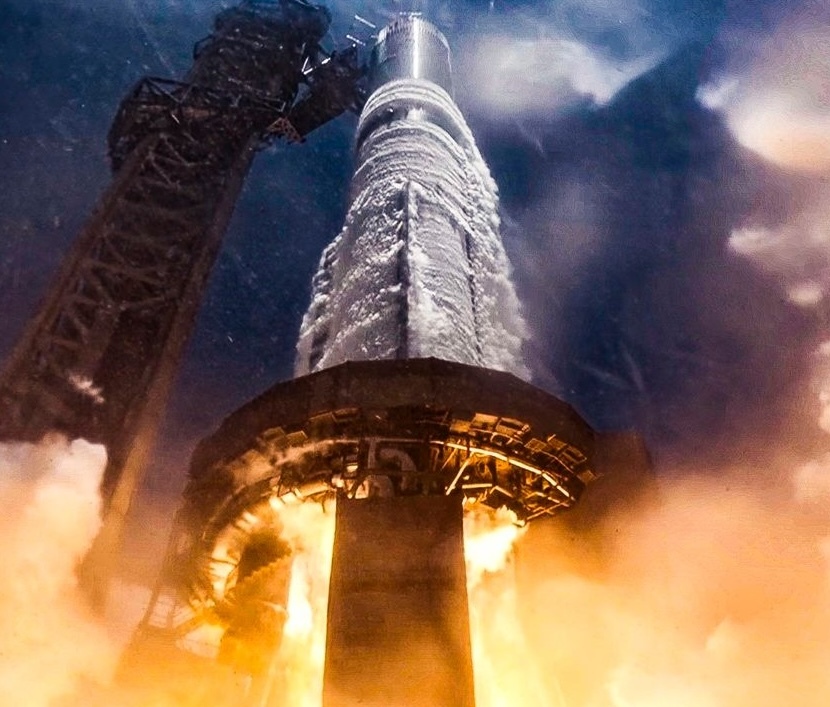
SpaceX is preparing to launch the tenth test flight of its Starship vehicle as early as Sunday, August 24, with the launch window opening at 6:30 p.m. CT.
The mission follows investigations into anomalies from earlier flights, including the loss of Starship on its ninth test and a Ship 36 static fire issue. SpaceX has since implemented hardware and operational changes aimed at improving Starship’s reliability.
Booster landing burns and flight experiments
The upcoming Starship Flight 10 will expand Super Heavy’s flight envelope with multiple landing burn trials. Following stage separation, the booster will attempt a controlled flip and boostback burn before heading to an offshore splashdown in the Gulf of America. One of the three center engines typically used for landing will be intentionally disabled, allowing engineers to evaluate whether a backup engine can complete the maneuver, according to a post from SpaceX.
The booster will also transition to a two-engine configuration for the final phase, hovering briefly above the water before shutdown and drop. These experiments are designed to simulate off-nominal scenarios and generate real-world data on performance under varying conditions, while maximizing propellant use during ascent to enable heavier payloads.
Starship upper stage reentry tests
The Starship upper stage will attempt multiple in-space objectives, including deployment of eight Starlink simulators and a planned Raptor engine relight. SpaceX will also continue testing reentry systems with several modifications. A section of thermal protection tiles has been removed to expose vulnerable areas, while new metallic tile designs, including one with active cooling, will be trialed.
Catch fittings have been installed to evaluate their thermal and structural performance, and adjustments to the tile line will address hot spots observed on Flight 6. The reentry profile is expected to push the structural limits of Starship’s rear flaps at maximum entry pressure.
SpaceX says lessons from these tests are critical to refining the next-generation Starship and Super Heavy vehicles. With Starfactory production ramping in Texas and new launch infrastructure under development in Florida, the company is pushing to hit its goal of achieving a fully reusable orbital launch system.
Quelle: TESLARATI
----
Update: 24.08.2025
.
STARSHIP'S TENTH FLIGHT TEST
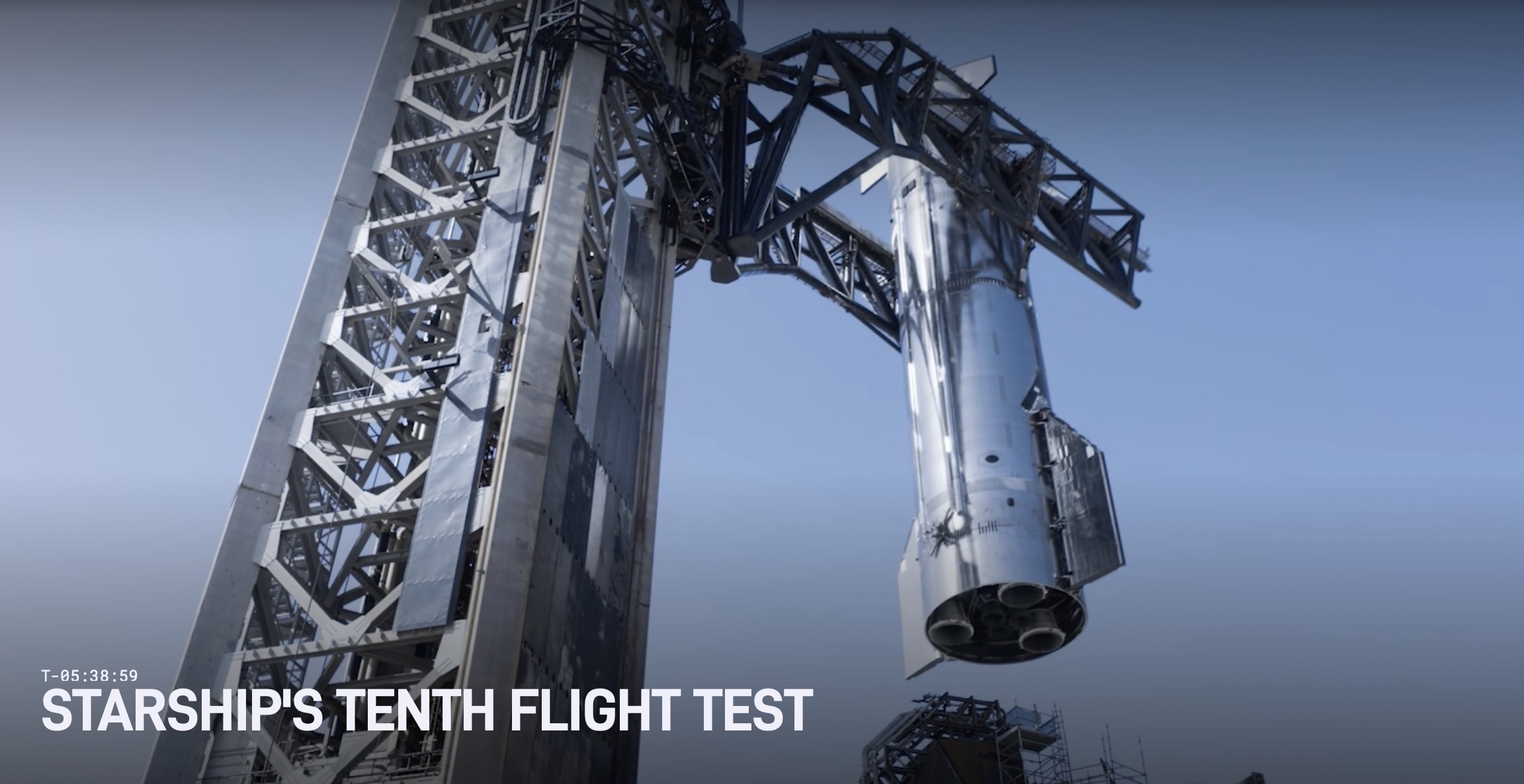
he tenth flight test of Starship is preparing to launch as soon as Sunday, August 24. The launch window will open at 6:30 p.m. CT.
A live webcast of the flight test will begin about 30 minutes before liftoff, which you can watch here and on X @SpaceX. You can also watch the webcast on the X TV app. As is the case with all developmental testing, the schedule is dynamic and likely to change, so be sure to check in here and stay tuned to our X account for updates.
After completing the investigations into the loss of Starship on its ninth flight test and the Ship 36 static fire anomaly, hardware and operational changes have been made to increase reliability. You can read the full technical summary of the investigations here.
The upcoming flight will continue to expand the operating envelope on the Super Heavy booster, with multiple landing burn tests planned. It will also target similar objectives as previous missions, including Starship’s first payload deployment and multiple reentry experiments geared towards returning the upper stage to the launch site for catch.
The booster on this flight test is attempting several flight experiments to gather real-world performance data on future flight profiles and off-nominal scenarios. The Super Heavy booster will attempt these experiments while on a trajectory to an offshore landing point in the Gulf of America and will not return to the launch site for catch.
Following stage separation, the booster will flip in a controlled direction before initiating its boostback burn. This maneuver was demonstrated for the first time on Flight 9 and requires less propellant to be held in reserve, enabling the use of more propellant during ascent to enable additional payload mass to orbit.
The primary test objectives for the booster will be focused on its landing burn and will use unique engine configurations. One of the three center engines used for the final phase of landing will be intentionally disabled to gather data on the ability for a backup engine from the middle ring to complete a landing burn. The booster will then transition to only two center engines for the end of the landing burn, entering a full hover while still above the ocean surface, followed by shutdown and drop into the Gulf of America.
The Starship upper stage will again target multiple in-space objectives, including the deployment of eight Starlink simulators, similar in size to next-generation Starlink satellites. The Starlink simulators will be on the same suborbital trajectory as Starship and are expected to demise upon entry. A relight of a single Raptor engine while in space is also planned.
The flight test includes several experiments focused on enabling Starship’s upper stage to return to the launch site. A significant number of tiles have been removed from Starship to stress-test vulnerable areas across the vehicle during reentry. Multiple metallic tile options, including one with active cooling, will test alternative materials for protecting Starship during reentry. On the sides of the vehicle, functional catch fittings are installed and will test the fittings’ thermal and structural performance, along with a section of the tile line receiving a smoothed and tapered edge to address hot spots observed during reentry on Starship’s sixth flight test. Starship’s reentry profile is designed to intentionally stress the structural limits of the upper stage’s rear flaps while at the point of maximum entry dynamic pressure.
Flight tests continue to provide valuable learnings to inform the design of the next generation Starship and Super Heavy vehicles. With production ramping up inside Starfactory at Starbase alongside new launch and test infrastructure actively being built in Texas and Florida, Starship is poised to continue iterating towards a rapidly and fully reusable launch system.
Quelle: SpaceX
